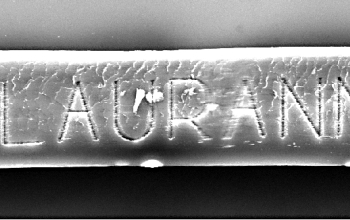Multimedia Gallery
The word "Lauranne" etched onto a strand of human hair
A scanning electron microscope image reveals the word "Lauranne" etched onto a strand of human hair. The etching was performed by Lauranne Lanz, a high-school student who participated in a month-long summer internship in July 2002 at the National Science Foundation-supported Materials Research Science and Engineering Center (MRSEC) at Johns Hopkins University.
Working in the lab and under the supervision of professor C.L. Chien, director of the MRSEC at Johns Hopkins, her assignment was to use a focused laser beam as a dry etching tool. The apparatus she used involved a high-powered pulsed UV (excimer) laser, focusing lenses and a computer-controlled, moveable sample stage. The laser beam is focused by lenses on a fine spot and effectively performs dry etching by ablating material from the illuminated spot. Lanz wrote a computer program to control the lateral movement of the sample stage to trace out patterns or words of her design in a continuous manner with sub-micron resolution. Simultaneously, her computer program controlled the triggering pulses for the laser light so that each sub-pattern or letter could be separately written. Lauranne first etched patterns and words of increasingly smaller sizes onto flat surfaces. She then explored the feasibility of labeling gemstones for microscopic identification purposes. Finally, on her own initiative, she successfully etched her name onto a strand of her hair as shown in the image.
The MRSEC at Hopkins supports an interdisciplinary research program on nanostructures with enhanced magneto-electronic properties. The research is carried out in one interdisciplinary research group, with appropriate seed projects. The center is engaged in a variety of educational activities including Research Experiences for Undergraduates and Research Experiences for Teachers, an undergraduate fellow program and a high-school teacher internship program. The center supports well maintained, shared experimental facilities that are accessible to outside users, and also interactive efforts within industry and other sectors. (Year of image: 2002)
Credit: Summer high-school internship of Lauranne Lanz, Oalkand Mills High School, under the supervision of prof. C.L. Chien, Johns Hopkins University.
Images and other media in the National Science Foundation Multimedia Gallery are available for use in print and electronic material by NSF employees, members of the media, university staff, teachers and the general public. All media in the gallery are intended for personal, educational and nonprofit/non-commercial use only.
Images credited to the National Science Foundation, a federal agency, are in the public domain. The images were created by employees of the United States Government as part of their official duties or prepared by contractors as "works for hire" for NSF. You may freely use NSF-credited images and, at your discretion, credit NSF with a "Courtesy: National Science Foundation" notation.
Additional information about general usage can be found in Conditions.
Also Available:
Download the high-resolution TIFF version of the image. (447 KB)
Use your mouse to right-click (Mac users may need to Ctrl-click) the link above and choose the option that will save the file or target to your computer.



